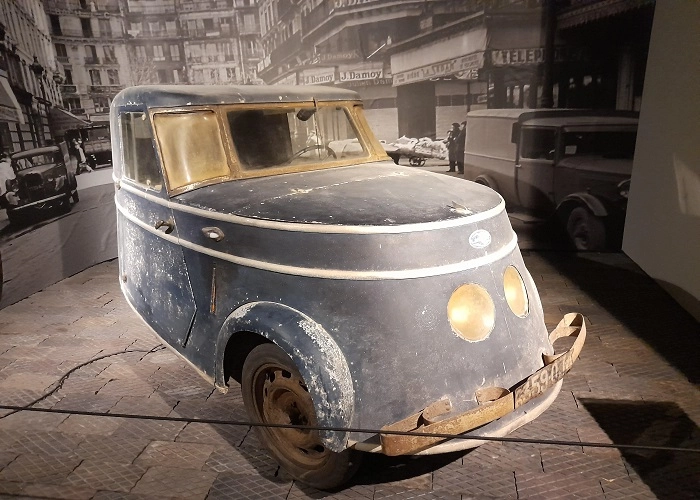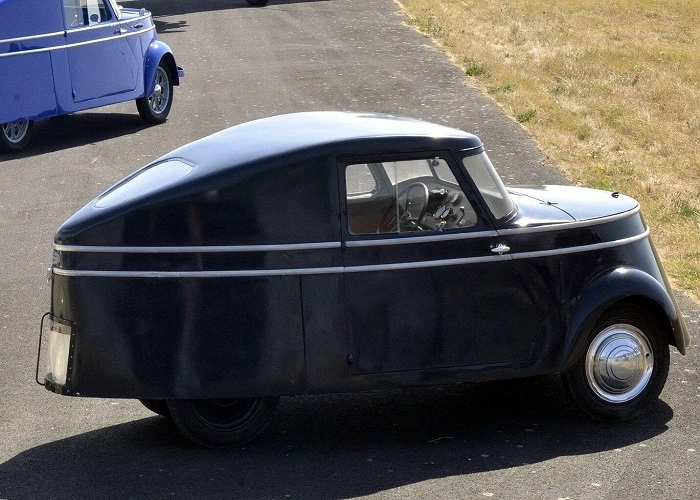The Breguet A2 was first manufactured in France in 1940 during the war when the company had to shift its focus away from creating airplanes. Production continued until 1945, marking the end of the war.
This electric vehicle was equipped with six batteries that totaled a voltage of 72V. With each charge, it could cover approximately 65 km at an average speed of 40 km/h.
During that time, its price was relatively high, reaching 56,000 francs, compared to the 36,630 francs required for a Citroën Traction Avant.
Out of the 200 units produced, only seven have survived to this day.


One of them is on display at the Regional Air Museum in the city of Angers, located in the French department of Maine-et-Loire.
Another vehicle can be found in the Louwman Museum, which was rescued from obscurity after spending 64 years in the garage of a French castle.
A third unit was auctioned by Artcurial three years ago, at Rétromobile 2017. With chassis number 94, it had belonged to the Breguet family and was estimated to fetch between 40,000 and 60,000 euros, ultimately selling for 41,720 euros.
How the War Led to the Creation of the Breguet A2?
The Société Anonyme des Ateliers d’Aviation Louis Breguet was established in 1911 and was known for its prolific production capacity and numerous technological innovations.
This company produced airplanes for civilian use and developed the Aeropostale service.
Furthermore, Breguet founded an airline in the 1920s, which later merged with Air France.
During the Nazi German invasion of France in the mid-1940s, Breguet had to cancel all of its military contracts. Consequently, military production was also suspended.
The Vélizy-Villacoublay factory was seized by the Nazis, forcing the personnel to relocate to the plant that was still under their control, in Toulouse.
To retain employees and manufacture a model that could withstand the wartime fuel shortages, the company decided to produce this electric vehicle.
In 1940, the first electron-powered car, the Breguet Type A1, was produced, using a 36 V electric motor supplied by the Paris-Rhône company. This model operated on six six-volt batteries.
Subsequently, the Type A2 was developed. It had a similar design but used six twelve-volt batteries.
This variation was not assembled at the Toulouse plant but rather in a small workshop located in the town of Anglet, between Biarritz and Bayonne in southwestern France.
The motor was supplied by Paris-Rhône, designated as TA 17, and power was transmitted to one of the rear wheels.
It had a forward gear with three different positions and a reverse gear that operated through reverse polarity.
It’s worth mentioning that in the first speed and reverse gear, the motor only operated on 36 volts. The second and third speeds used 72 volts.
The batteries were grouped in sets of three, located on the front axle and under the rear seat. This meant that only a maximum of three people could travel in the vehicle.
Its body attracted attention for its resemblance to an airplane cabin, which is not surprising considering the company’s aviation background.
The front was adorned with two circular headlights in the center and a three-part divided front windshield.
The rear track became narrower to accommodate the electric motor between the two wheels, eliminating the need for a differential (only one wheel received power) and saving weight.
All four wheels had pedal brakes and a manual handbrake that locked one of the rear wheels.
The Rise of Electric Vehicles During the War
Another example of the commitment to designing electric vehicles during wartime was the “electric egg.”
The artist and graduate of the National School of Fine Arts in Paris, Paul Arzens, built this model, claiming it would be the “future” of automobiles.
This model, which challenged the conventional design of vehicles, had 300 kg of batteries located at the rear and housed under the seats.
These batteries provided a range of 100 km, which was a considerable autonomy for its time.
As for its maximum speed, the electric egg reached 70 km/h.
Read more: Electric vehicle sales are growing in France and surpass those of 2022







